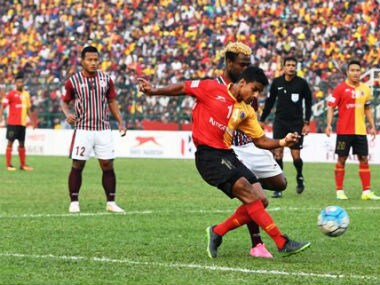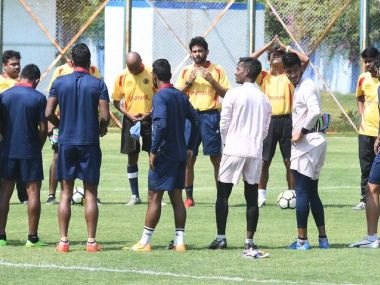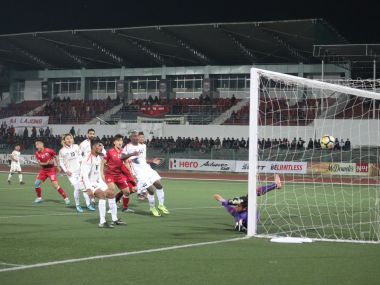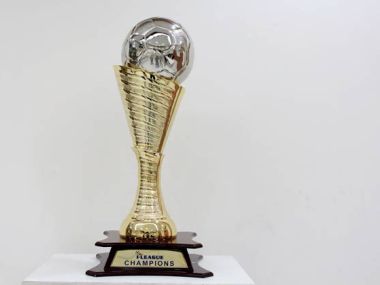It is great to witness India’s national football league, I-League, throw up a first-time champion for the second successive season. It is disheartening to reflect on what that says about the state of Kolkata clubs Mohun Bagan and East Bengal, the two giants of Indian football who demand respect from the football fraternity but fail to command it.
Last year, Aizawl FC, the minnows from Mizoram who went from relegation to champions in one year, pipped the Kolkata teams to the title. And did so on a budget less than the wages of Mohun Bagan’s Haitian star Sony Norde. This year, it’s Minerva Punjab FC, who catapulted from second-from-bottom in their debut campaign to lifting the trophy in their next.

An East Bengal versus Mohun Bagan match underway. Twitter/@ILeagueOfficial
Losing the league once to less-fancied opposition could be chalked down to a freakish one-off season. But two seasons in a row? It is indicative of a much deeper malaise within these clubs, especially in a season which heavily favoured them.
“The Kolkata clubs will fight for first and second positions,” Minerva owner Ranjit Bajaj had told this author last summer, several months before the season began. “But third position will be up for grabs and that is within our reach.”
Bajaj’s words told the reality of the I-League. Bengaluru FC, which completed the triad of ‘big clubs’ in the league, had opted to play in the Indian Super League (ISL), leaving Mohun Bagan and East Bengal as clear favourites. Teams were also allowed to field five foreigners, one more than the previous seasons, which in theory aided the financially-richer Kolkata duo.
With two leagues running in parallel, Indian football’s food chain was set in motion. ISL clubs stripped the Kolkata teams of their top Indians, which in turn meant the duo dished out the same treatment to other I-League clubs. Bagan recruited the likes of forwards Asier Dipanda and Ansumana Kromah, who were the best players at their respective I-League clubs in the previous year, whereas East Bengal raided Aizawl for their title-winning coach, Khalid Jamil, and also nabbed some of the Mizo club’s top players.
On paper, the 2017-18 I-League was a lopsided one that no club outside of Kolkata should’ve had a chance of winning. But when you rely heavily on individuals and don’t have a football philosophy to bank upon, you run the risk of being left behind by teams which do.
Both Aizawl and Minerva had inferior talent on the pitch but superior cohesion and planning. They had an identity as well. Aizawl’s short-passing style of play resonated with the fans and helped outplay opponents, while Minerva’s direct method, though not pleasing to the eye, was tailor-made to the team’s strengths and yielded results.
What style of football do you associate with Mohun Bagan or East Bengal in recent years? A disjointed one, if nothing else, where the whole becomes much less than the sum of its parts.
Under head coach Sanjoy Sen, Bagan’s dependency on Norde was embarrassing for a club of its stature. In a drawn game at home to NEROCA FC early in the season, Sen fielded an unfit Norde out of sheer desperation. It proved to be a costly gamble. Norde aggravated his injury and did not feature again. Sen too resigned soon after a string of poor results which saw Bagan failing to beat NEROCA, Shillong Lajong, Chennai City and even Indian Arrows, a developmental side comprising young Indian players.
Indeed, Bagan were hampered by injuries and performed better in the latter half of the season. Aside from Norde, Kromah was forced to play without being fully fit and midfielder Yuta Kinowaki missed two-thirds of the season. Against Lajong at home, the Mariners fielded only two foreign players — the only club other than newcomers Gokulam Kerala FC (and Indian Arrows) to field two or fewer foreigners in a match. This was also down to poor management. Australian midfielder Diogo Ferreira had struggled to adjust to the Indian conditions and wasn’t registered in the squad, but he wasn’t replaced either. He left in December without playing a match. For half of this season, Bagan had five foreign players in the squad, one less than the six allowed, and two of them were injured.
It is difficult to sympathise with the Kolkata clubs amid an inescapable sense of irony. They had aggressively pushed for an increase in the foreign player quota to serve a selfish motive (draw parity with ISL’s Kolkata franchise ATK) at the expense of greater good, whereas the likes of Minerva, who eventually had the most impactful foreigners, had protested against the change.
East Bengal, on the other hand, tried to import Jamil’s league-winning philosophy but ended up with his unambitious mentality. It’s hard to question a coach who scripted Indian football’s finest fairy-tale the previous season but there’s little doubt that Jamil’s tactics to shut up shop after taking the lead hurt his team’s chances.
Jamil did not play to his team’s strength — its attack — and paid a heavy price for it. East Bengal dropped a league-high 11 points from winning positions. During the final stages of the season, and with nothing to lose, Jamil’s side went all out against Chennai City and won 7-1. The next game? A 2-2 draw in Shillong, where a rampant East Bengal, who had the title in their hands, took an early lead but immediately conceded the initiative. In hindsight, it’s fortunate that Jamil’s Aizawl team had a habit of opening the scoring late in matches (five 1-0 wins with goals after the 75th minute), leaving little room for the coach to lock things up.
An intense, unforgiving and demanding football ecosystem in Kolkata does not help matters. It is certainly unique, just not always in an admirable fashion. The city is home to India’s most knowledgeable and passionate set of supporters but also its most critical fan base, which turns on players and coaches at the first glimpse of failure.
Last year, fans protested against East Bengal head coach Trevor Morgan after a home loss to Churchill Brothers. At the time, Morgan’s side were league leaders during a season in which they had equalled the club’s record six-match winning streak. Earlier this year, Mohun Bagan fans spat on head coach Sen and reportedly hurled bricks at him. Players have had run-ins too, obscene gestures exchanged and vehicles damaged. Club officials haven’t been spared either, obviously. Simply put, it isn’t the most welcoming environment for talents to flourish in or for philosophies to patiently develop.
Kolkata’s resistance to modernisation is lamentable too. It’s fast losing relevance and goodwill outside of the city, even with those who saw Kolkata’s 'big two' as the flag-bearers of the fight against the perceived tyranny of the ISL. For Indian football’s ever-growing young fan base, Kolkata clubs are becoming the teams their grandparents talk about, and nothing more.
Mohun Bagan have won the league once in 16 years. East Bengal haven’t in 14. If they couldn’t lift the trophy this season, then when?
Published Date: Mar 10, 2018 23:06 PM | Updated Date: Mar 10, 2018 23:06 PM


